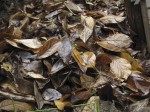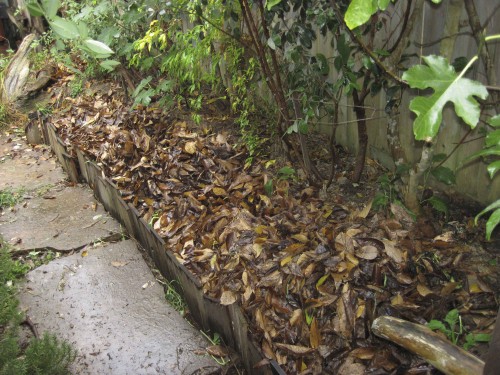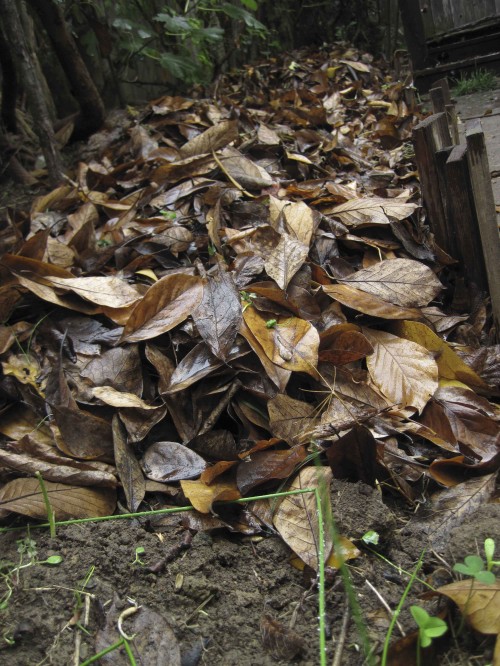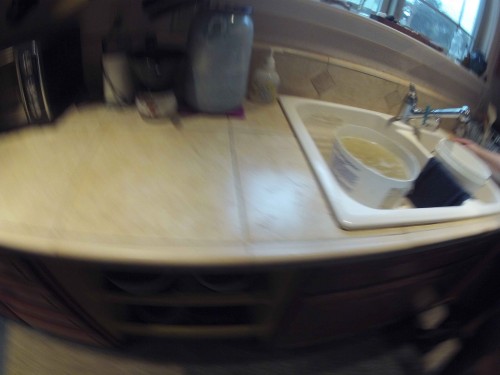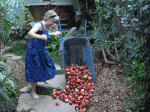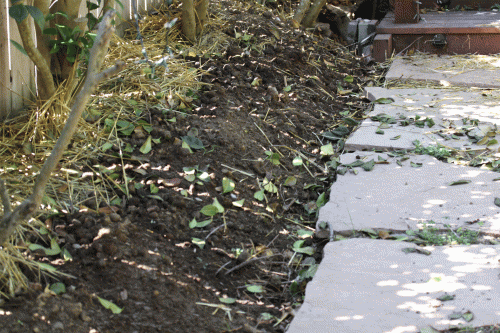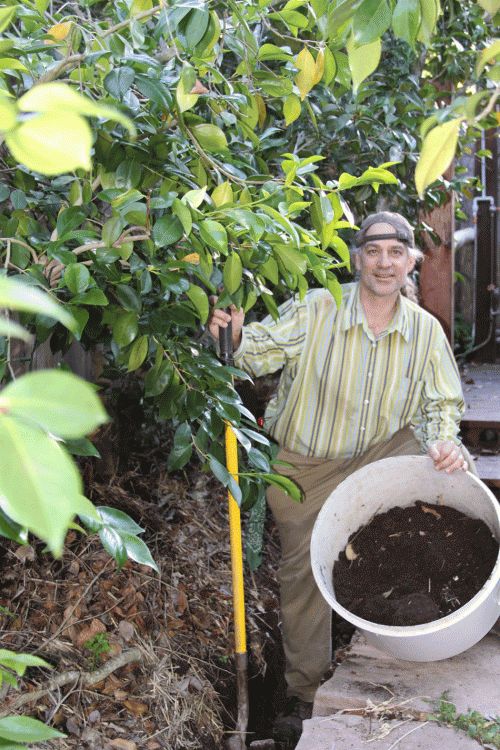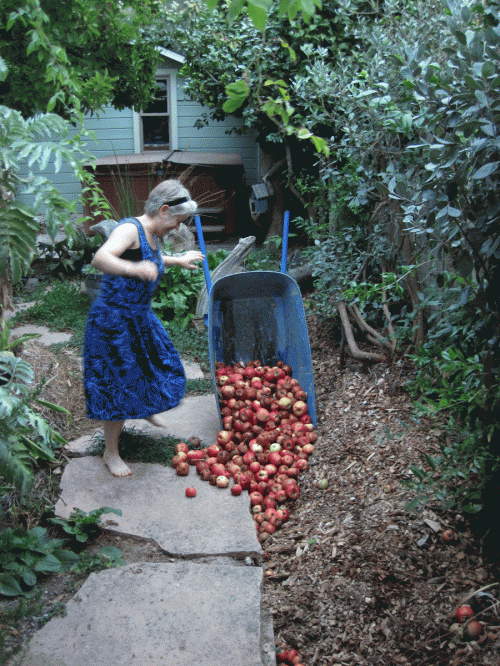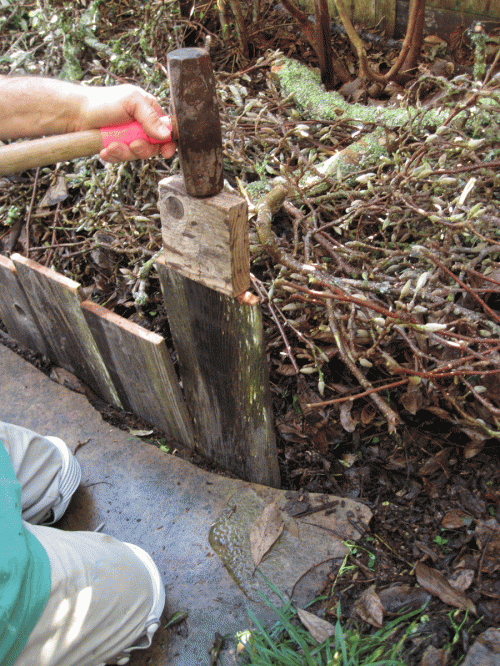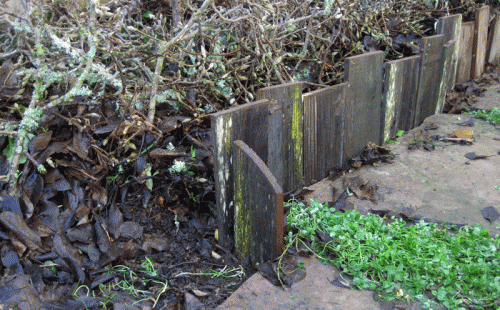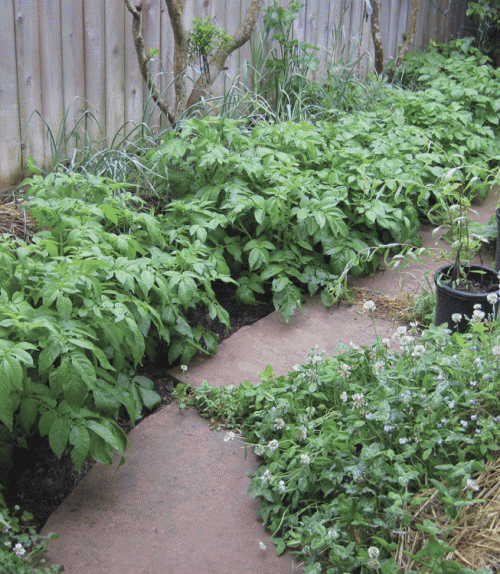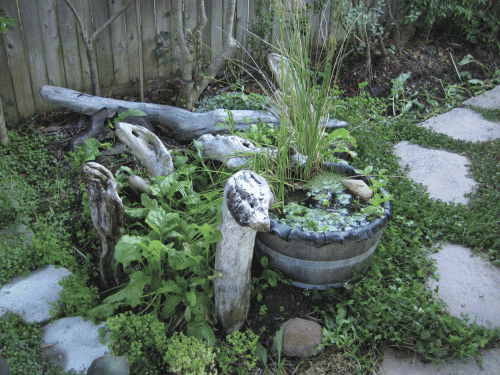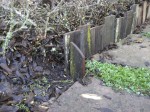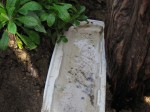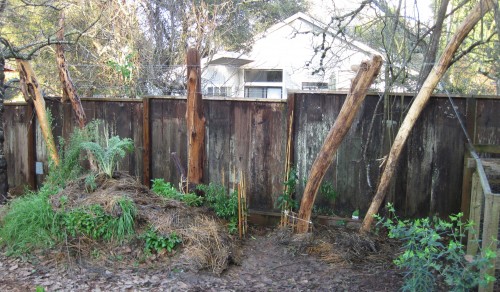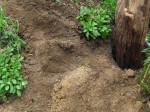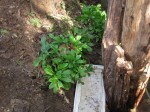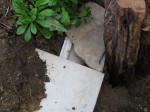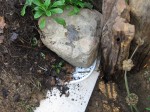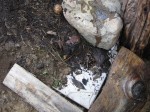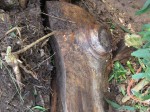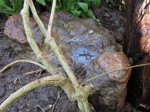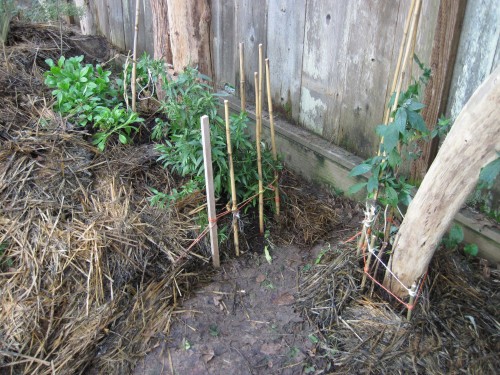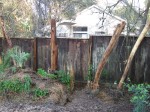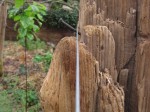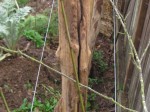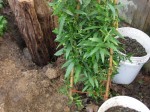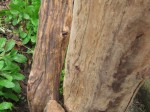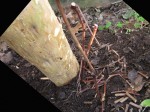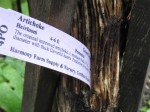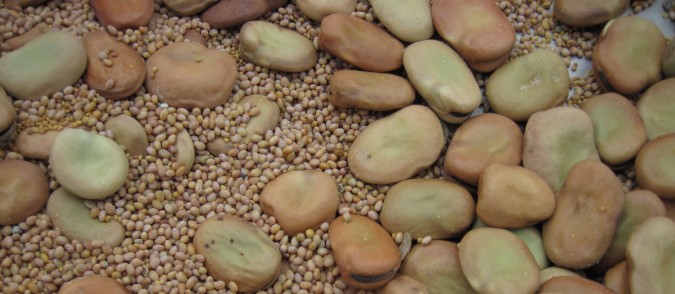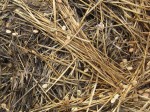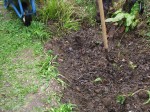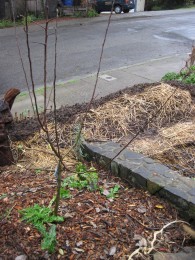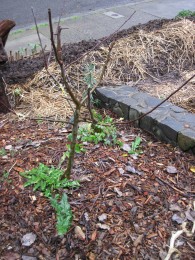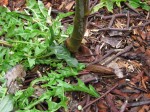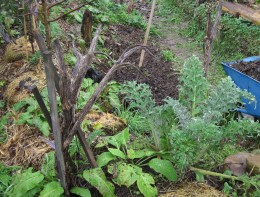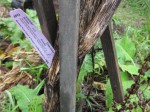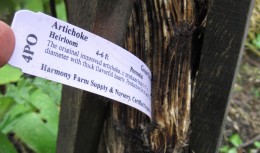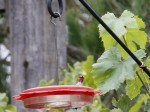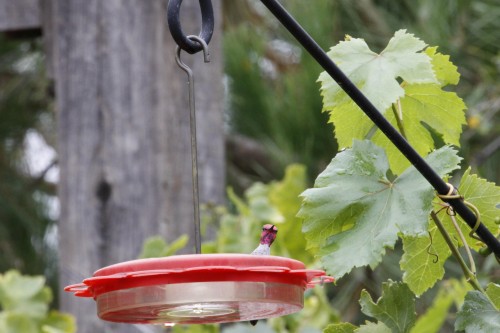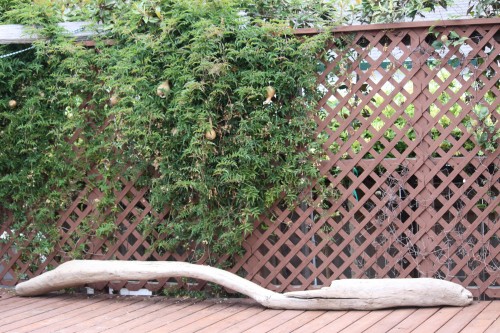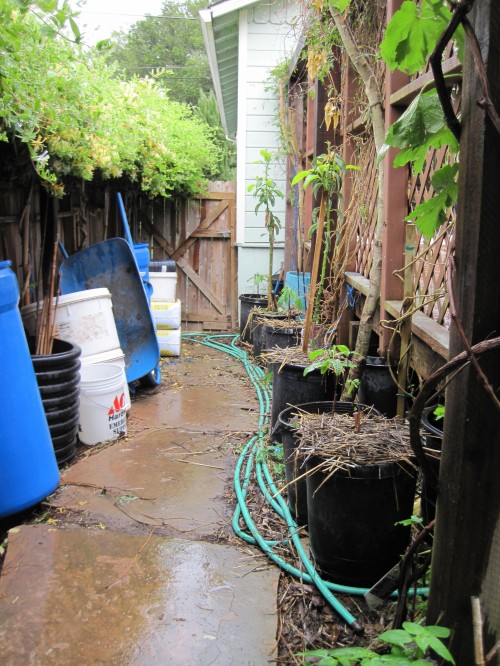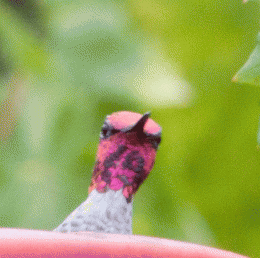Garden Log (what I did):
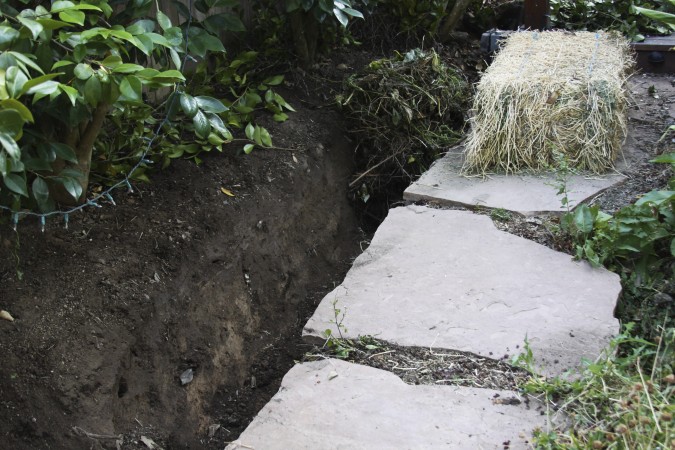
071509 Leaf Trench Highway. Soil has been harvested from the trench, between the slate walk path and the planting bed. The trench will be prepped for more soil making, starting with a base of straw from the awaiting bale. Since this picture, lots of organics have been composted onto and into the trench. Those organics include: tree prunings, wheat straw, alfalfa straw, oak leaves, carbon harvest (for example, pumpkin vines), twigs and stout tree limbs, wood chips, and horse manure. Beautiful, rich, high quality tilth soil has been harvested several times from the trench.
1. Constructed a low retaining wall to increase the soil volume of a planting bed, Leaf Trench Highway. Leaf Treanch Highway got its name back in 2007 when we were installing irrigation supply to our garden’s back corner. The water supply was trenched along a walk path, buried about three (3) feet and encased in 3″ perforated plastic drainpipe. The depth and casement were to allow “mistakes” in the garden — a shovel could graze the drainpipe and might not break through and bust the water supply. Lots of digging since then, and no busted trench pipe, yet. The trench was called a “highway” because, when filled with leaves, or other organics, it’s a corridor for critters to move about the garden.
So, there we were, in 2007, with a sizeable 3-foot deep trench running along the property line’s planting bed. We decided to use the trench to make soil; we would use the trench to turn compostable material into planting soil.
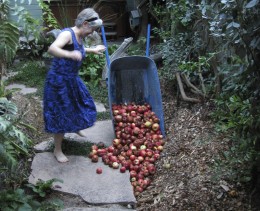
"Opps! Did I spill that?" No, Anita, Leaf Trench Highway is getting a rotten apple harvest -- Sebastopol's finest for our dear soil-making critters.
About every six months, the trench is dug up for a soil harvest. That harvested soil is then used to amend the soil in the gardens. And yes, sometimes waiting the six months or so is difficult. But having fresh, new, teeming-with-microbe, alive! soil on hand when we do harvest is all that much more a treat after the wait.
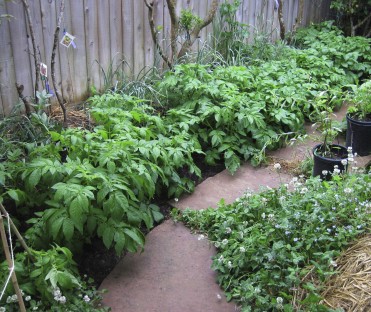
Potato (broad-leaved), garlic (along fence), red and white clover grow in Leaf Trench Highway in the summer of 2010. The red and white clover serve as both insectary and nitrogen-fixing plants.
This time around, in 2012, I want to grow a crop above the composting trench. I want us to produce a garlic and vegetable crop WHILE the trench is composting. I have also found that new crop love a good compost under it. BUT, the compost can not be too hot or the new crop will burn. For this planting, there is a good base of wood chips, green manure, oak leaves, and a recent magnolia tree pruning. Especially with the magnolia twigs and limbs, those bulky organics will supply microbes, miosture, and nutrients to the growing crop. Also, as the crop plants grow, their roots will travel the moist, nutrient-rich paths along the decaying wood. Great mulch for the coming dryer months. Throughout the spring, we will harvest salad from the composting trench. By July, the garlic will be ready to be dug up — harvest garlic, harvet soil. Garlic for the kitchen, soil for the garden.
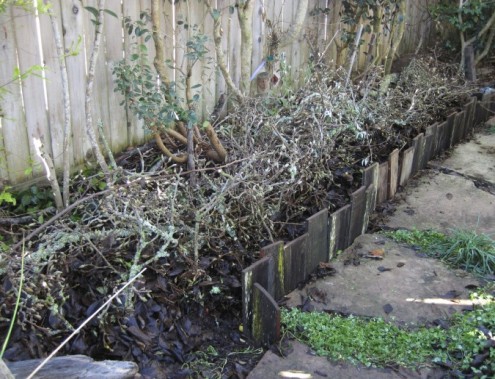
Low retaining wall built to increase the soil capacity of Leaf Trench Highway's planting bed. Old redwood fence boards were cut in two-foot lengths and pounded into the gap between the planting bed and the vertical slate border. Using a wood block between the fence board and the sledgehammer kept the fence boards from splitting.
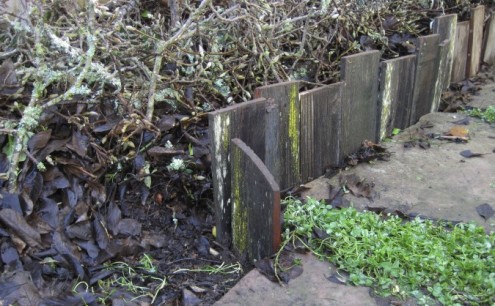
20120108-LTH-retaining-wall, close-up. Note the beautiful mosses and lichens on the old fence board. Not only is this FREE!!! redwood fence board functional (it will last many years in the soil), it is also beautiful. Moist soil from the planting bed was rubbed into the board cuts to instantly age those fresh-cut surfaces -- we are talking art here! I am interested to see if that soil smear will promote moss growth on the top edges of the boards. Stay tuned.
2. Manure run. Collected both hot (fresh) and cold (old) horse manure from my secret source (nothing personal). The hot manure was laid down at the bottom of the fence boards to create a little heat for the wintering crops. The cold manure, which is pretty much a sandy loam soil because it has broken down for so long, was thrown on top of the bed. That cold manure was thrown into and on top of the magnolia tree prunings, enough of it to plant the crops in.
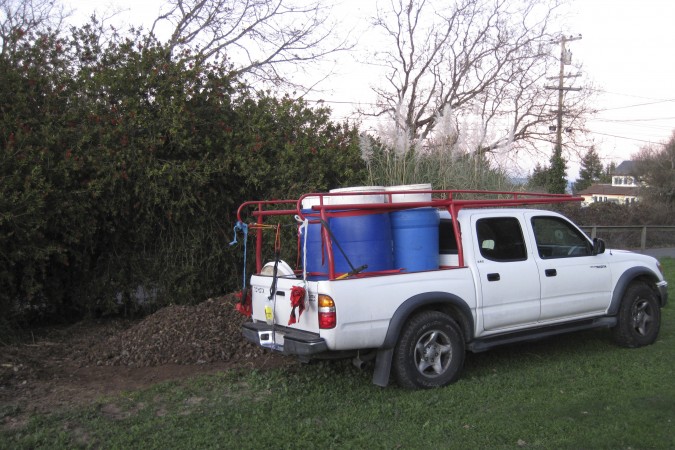
Collecting horse manure from a neighbor's pile. The bins/barrels help keep the job cleaner and easier. Using the barrels, my truck does not have to be washed afterwards and the manure can sit in the bins until ready for use. Sure is nice to load it once (into the barrels) but not have to clear it out of my truck's bed the same day. Note the looseness of the fresh (hot) pile at the rear of the truck. That pile was moved twice -- once to get it out of the way so the buried old (cold) manure could be harvested, then again to fill up the hole that cold manure harvest left. Perhaps in 6 months, that filled in hole will be cold manure soil itself. Just another example of our wondrous revolving World at work.
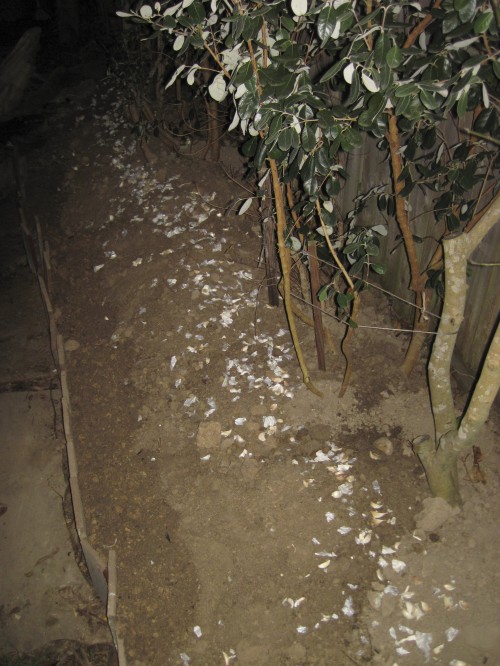
It's late, but the garlic is in. Come tomorrow, I will throw a thin mulch of rice straw over the veggie seeds and garlic starts. Note how the low retaining wall of recycled (reused) fence board allowed enough soil to be added to the bed to cover most of the magnolia prunings. Will be exciting to see what crops actually do rise out of the straw mulch and to see how well they thrive in this compost, soil-making bed. Oh, did I tell you -- it's an experiment. 🙂
You, the Habitat Gardener (reflections):
1. Leaf Trench Highway is a major no-toll pathway in our garden. True, there is often construction along this roadway, but the improvements are always worth it. This year’s road upgrades include last year’s woodchip pile from Santa Rosa’s waterways cleanup (oak and willow), oak leaves from the neighborhood, our ridiculous Jack-in-the-Beanstalk pumpkin patch green manure, the magnolia tree’s prunings, hot manure, and cold manure soil. Microbes party down! All insects and amphibians welcomed. Just add water, as the soon-to-come rains will do, and the entire length of Leaf Trench Highway will be a mess of healthy fungi, vegetables, flowers, microbes, crawly critters, and birds. And that’s just at ground level. The length of the trench, along the fence, is a fedge — food hedge, a permaculture term. That hedge planting includes fig, pineapple quava, loquat, and pomegranate.
2. Our soil gets better every year as we grow more food each year. And we share — without an atom of pesticide, herbicide, or fungicide, the trench and fedge will take on a natural balance. The critters will get some of the planted crop, but by far, we will get our fair abundant share.
Happy soil making to you.
Tony
The Next Day and Night:
1. More cold manure soil was added to the bed tocover the garlic and to give the veggie seeds more soil to establish themselves in.
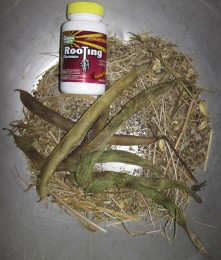
Bowl-O-Seeds. Rooting powder was used to help the seeds germinate, a tall task during these wintery days.
2. The vegetable seeds were all mixed together with rooting powder (only because I didn’t have any mycorizzae spore on hand). Life is good!, especially when I get to open dozens of seed packets that I prepared throughout last growing season. Round and round, mixed in a large stainless bowl, or bucket, and dusted with a little love (spore or rooting powder). Then I’ll carefully toss the seeds out onto a prepared planting bed — a dash here, a dash there, some over my right shoulder, some underhanded between my legs. Most importantly, I get to have fun being ridiculous. I get to plant way too many seeds. Yes, I work hard to collect seeds all year long so that I can have a Chia Pet garden. Too many plants that grow too much means I will eventually get to havest them, in whole or in part, and reap the green manure they are. I will be harvesting carbon — all that alive, green plant material is merely bottled up sunshine to be poured onto the compost pile. Sun >>> plants >>> photosynthesis >>> juicy packets of carbon >>> Tony’s compost >>> SOIL MAKING. And with that carbon-rich soil, we will grow more STUFF, whether it be flowers, food, or fodder. And we will live happily ever after.
The seeds I grew and collected and mixed together are cilantro, parsley, Queen Anne’s lace, bok choy, gopher plant, impatiens, fennel, round zuccini, calendula, “Primo” danelion, and chard. Store-bought seeds that also became part of the mix are broccoli, cauliflower, and lettuce. SOMETHING ought to grow!
3. The seeded bed, also with its garlic starts, was mulched with rice straw to keep critters away from the seeds and to keep the seeds moist for germination. The mulch will also help the seeds receive waterings and/or rain without being washed out of the planting bed. Perhaps too heavy a cover of straw to be left on the young sprouts. BUT, I will keep an eye on the bed and will thin off some of the straw in a week or two. I will be curious to see what plants actually do come up during these frosty nights and cool days. Nice to have some ground warm perculating upward toward the seeds from the hot manure below. Even if nothing were to germinate now, surely some seeds will germinate further down the year when the sun warms the soil and spring rains moisten it. How fun to wait and see.
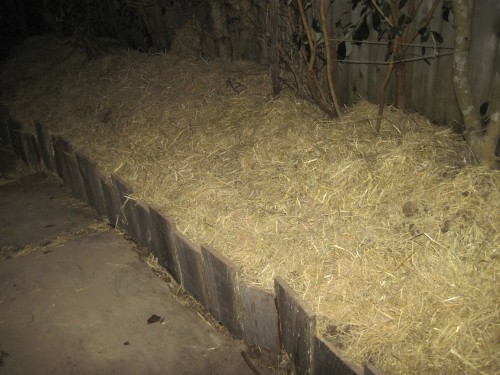
The seeds have been sown and the rice straw mulch is in place. A little water. A lot of waiting. Soon enough, though, a forest of food and flowers.
